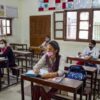How remote education is impacting students and teachers
 – Dhwani Jaipuria, Director, SRJ Edu Services Pvt Ltd
– Dhwani Jaipuria, Director, SRJ Edu Services Pvt Ltd
Technology is a great boon for education, but it should complement – not replace – the personalized teaching and learning experience in brick-and-mortar classrooms.
Remote education, facilitated by online learning platforms, indeed has its pros. It lends freedom and flexibility to the pedagogical process. Using technology, students and teachers can communicate at a distance and at a time of their choosing. Young aspirants in far-off places who previously had little access to education can now avail it online by upgrading to better technology. Simply put, remote learning is taking education from classrooms to homes.
This is unprecedented but merits a deeper analysis to better understand the long-term implications of the increasing reliance on remote learning, particularly in light of the Covid-19 pandemic.
As a stopgap measure, remote learning has been a lifeline for the education sector during this pandemic. But should remote education become the norm rather than the exception? Should it take the centre stage and push classroom education to the side-lines?
We may arrive at some answers by studying the impact of remote learning on students and teachers.
Impact on students
- Young preschool students need a teacher’s personalized attention to develop basic faculties of comprehension, cognition, and critical thinking. Remote education, being virtual and impersonal, can’t match up to the participative teaching methods of a classroom.
- Students with limited means may not have access to the technology and online tools needed for remote education. This may cause a learning gap between the haves and have-nots.
- For all its benefits, remote education isn’t proving to be of much help to the disadvantaged students with visual, hearing impairments and learning difficulties. Such special-needs students require a teacher’s physical presence.
- Remote education takes away a cherished part of school life: the social interactions with friends and the cumulatively shared fun of co-curricular activities such as sports and performative arts. These are particularly important for little kids in early developmental stages and their lack may negatively impact children’s social behaviour and outlook.
Impact on teachers
- Remote learning makes it necessary for teachers to adapt to new technologies. Though this makes them more tech-savvy, the impersonal mode of teaching may affect their skills in ways yet to be fully understood.
- Creating follow-up lessons and customized instruction is a lot more complex in remote education, as opposed to the classroom environment where real-time personal interaction with students enables a teacher to engage the entire class at once.
- Assessment of academic performance is more accurate in the old model classroom education. Teachers have to adopt innovative ways and even take a leap of faith to judge a student’s performance in remote education.
Is blended learning the future of education?
Blended learning combines the best aspects of both classroom and remote education. It takes rigidity out of the traditional teaching and learning methods without making them impersonal. Students of all ages, streams, and different intellectual and physical abilities can benefit from blended learning and make it the delivery model for education in the future.
Also read: Financial education is imperative to build an economically stronger India
The views, thoughts, and opinions expressed in the article belong solely to the author, and not necessarily reflect the views, thoughts, and opinions of EducationWorld.















Add comment